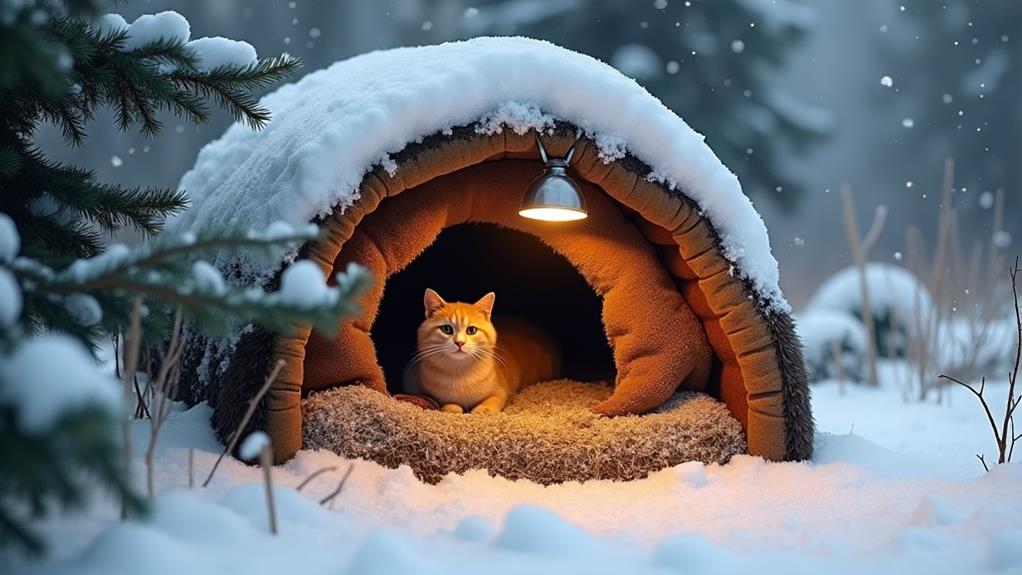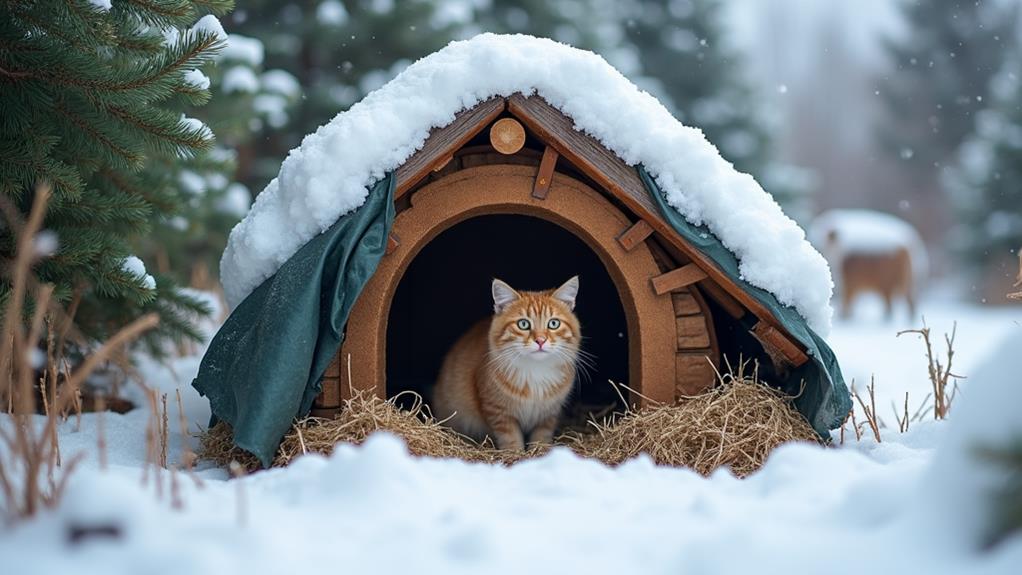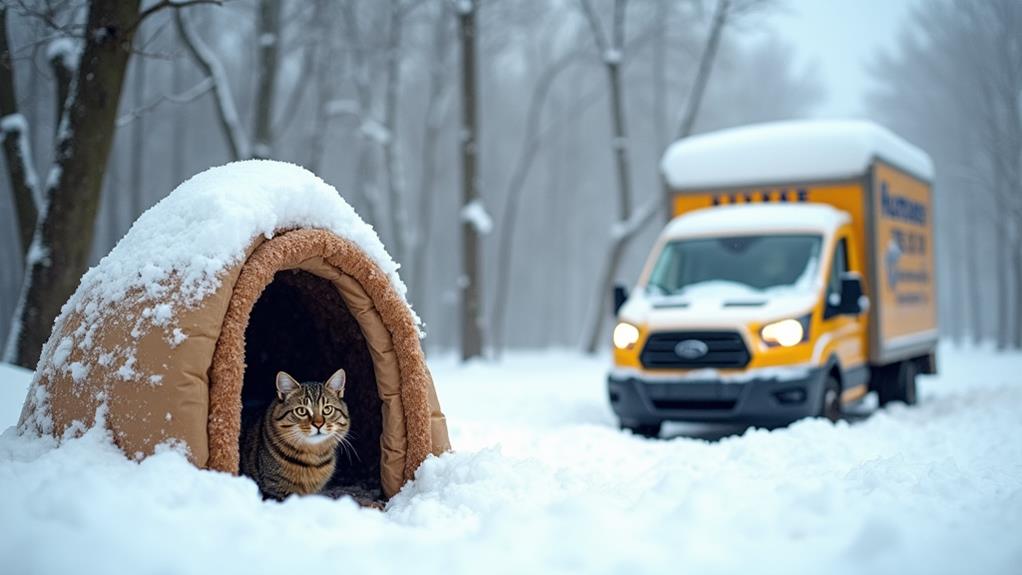How to Keep a Feral Cat Warm in Winter: Shelter and Safety Tips

To keep a feral cat warm in winter, build a shelter that's 2x3 feet and 18 inches high to retain heat. Use plastic containers lined with Styrofoam for insulation, and fill the shelter with straw or shredded newspaper, not blankets. Raise the shelter on bricks or pallets to prevent dampness. Provide access to fresh water in insulated bowls and increase food portions to meet energy needs. Check vehicles before driving to verify no cats are sheltering inside. Educate your community on these practices to protect feral cats through harsh winters and investigate further methods to improve their safety.
Building Effective Cat Shelters
When you're looking to keep feral cats warm through the harsh winter months, building effective cat shelters is essential. You should aim to create shelters that measure around 2x3 feet and stand 18 inches high. This size is perfect for trapping body heat, which is vital for proper insulation. Use materials like straw for bedding, as it retains heat well and keeps feral cats cozy.
To protect these cats from the cold and potential predators, design your shelter with a small entryway equipped with a flap. This feature blocks cold air and improves security. Raise the shelter slightly off the ground to prevent dampness and potential flooding, ensuring a dry and warm environment.
If you're into DIY projects, consider using large plastic containers lined with Styrofoam. Cut a small doorway for access and fill the inside with straw. It's a simple yet effective way to build a shelter. Don't forget to perform regular maintenance, like removing snow from entrances and checking cleanliness. This keeps the shelter accessible and safe. For larger colonies, multiple shelters are better, as small shelters trap heat more efficiently than larger ones.
Insulating Materials to Use
Constructing effective shelters is just one aspect of keeping feral cats warm in winter; selecting the right insulating materials is just as vital. Straw is your preferred option. It retains heat more effectively than blankets or towels, which can absorb moisture and end up chilling the cats instead. Unlike hay, straw doesn't hold moisture and won't mold, keeping the shelter dry and safe.
If you can't find straw, shredded newspaper can serve as a lightweight substitute. Though not as effective as straw, it does provide some warmth and is easy to replace when it becomes damp. For lining the shelter's interior, consider using Styrofoam panels. They offer excellent insulation and help trap the cats' body heat, creating a cozy environment.
Mylar blankets are another excellent choice, especially in extreme cold conditions. These reflective materials can be placed inside the shelter to bounce back the cats' body heat, enhancing general warmth. Just remember, while mylar blankets are effective, they should be used in addition to, not instead of, other insulating materials like straw or Styrofoam. By selecting the right insulating materials, you greatly increase the comfort and safety of feral cats during harsh winter months.
DIY Shelter Construction Tips

How can you create a cozy haven for feral cats during the biting winter months? Start by constructing a DIY shelter using large plastic containers. Line these with Styrofoam for insulation and cut a small doorway to help trap the cat's body heat. Smaller openings also offer better protection from the elements. For insulation, avoid using blankets or towels; they absorb moisture and can make the space cold. Instead, fill the shelter with straw, shredded newspaper, or packing peanuts to keep it dry and warm.
If you have foam coolers lying around, repurpose them by cutting access holes. These coolers provide an insulated space perfect for outdoor cats. Raise the shelter using bricks or pallets; this prevents dampness and guarantees proper drainage, enhancing its insulation properties. Regular maintenance is vital. Check the shelters frequently, especially after snowfalls, to clear entrances and keep the interior dry. Remove any debris that could compromise warmth and safety.
Building a DIY shelter for feral cats doesn't have to be complex. With the right materials and regular upkeep, you can offer them a safe, warm refuge throughout the harsh winter months.
Food and Water Management
Guaranteeing feral cats have access to food and water during winter is fundamental for their survival. Position food and water stations close to insulated shelters. This minimizes the distance cats need to travel in the cold, making it easier for them to access important resources. Consider creating a canopy or protective covering between two shelters. This shields the food and water from harsh weather conditions, maintaining their accessibility and quality.
Use insulated bowls to help keep water from freezing. You might also try solar-heated water dishes as a method to delay ice formation. Regular monitoring of food supplies is significant. Replace any spoiled or frozen food promptly to guarantee cats receive fresh and digestible nourishment. During extreme cold, increase the food portions you provide. Cats expend more energy to maintain body heat, so they need extra food to meet these increased demands.
Ensuring Water Accessibility

With winter's chill, it's essential to guarantee feral cats have consistent access to fresh water. Frozen water can lead to dehydration, so it's imperative to keep water accessible. Insulated dishes are a great solution, as they help prevent water from freezing. Using silicone bowls or thick plastic containers can also improve insulation, making it easier to manage ice buildup and keep water available for cats.
Regular monitoring of the water bowl is fundamental. Check frequently to verify the water hasn't frozen, and promptly remove any ice. This allows you to refill it quickly, ensuring the cats always have access to fresh water. If you're dealing with extreme cold, consider using heated water bowls. These can effectively keep water from freezing, supporting the cats' hydration needs.
Positioning water bowls is just as significant. Place them away from shelters to maintain warmth inside while the cats can easily find the water. By placing insulated water containers near shelters, you can create a balance between warmth and accessibility. These strategies will help you keep water available and prevent dehydration, safeguarding the well-being of the feral cats you care for this winter.
Safety Measures for Winter
As the temperature drops, it's important to implement safety measures to protect feral cats during winter. Feral cats often seek warmth in unexpected places, like vehicle engine compartments. Before you drive, inspect your vehicle to confirm no cats are hiding underneath. It's a simple step that can prevent injuries or worse.
When managing feral cat colonies, opt for pet-safe de-icing products. Traditional de-icers like salt and antifreeze can be toxic, posing significant health risks to cats. Keeping your shelter areas free from harmful chemicals is significant in extreme weather conditions.
Regularly check shelters and feeding stations to clear away snow and confirm these areas remain accessible. Accumulated snow can block entry points, preventing cats from accessing food and warmth. Keep these spaces clear and functional to support their survival.
Monitoring the environmental conditions is important. During extreme cold snaps, limit outdoor access for feral cats to prevent overexposure to harsh elements. If possible, offer them temporary indoor shelter or confirm their outdoor shelter is well-insulated.
Lastly, educate your community on the importance of caring for feral cats in winter. Promoting humane practices and supporting local TNR initiatives can make a significant difference.
TNR Practices in Cold Weather

Winter can pose challenges for Trap-Neuter-Return (TNR) efforts, but some strategies can help mitigate these issues. Initially, you'll want to conduct TNR during the warmer parts of the day. This timing guarantees that cats spend minimal time in traps, reducing their exposure to cold weather. It's important to check traps regularly, so cats aren't left exposed to harsh winter conditions for long periods.
After surgery, providing adequate shelter is essential. Cats need a warm place to recover from the stress of trapping and anesthesia. Make certain to have insulated shelters ready, equipped with straw or other insulating materials, so they have a cozy recovery space. This preparation is significant in maintaining their health and guaranteeing a swift recovery.
Winter TNR practices can also be advantageous in reducing the number of pregnant cats trapped. This aspect simplifies the management process and helps control the population effectively before spring kitten births. While community involvement is significant, your direct efforts in building shelters and feeding stations can improve the success of these initiatives. By implementing these strategies, you can continue your TNR work efficiently, even in cold weather, while keeping feral cats safe and warm.
Community Involvement Strategies
Guaranteeing feral cats stay warm during the winter isn't a task you have to tackle alone. By involving your community, you can create an effective support system for community cats. Start by organizing events to educate local residents on winter care, like workshops that teach how to build homemade shelters and set up feeding stations. These gatherings can foster a sense of shared responsibility and guarantee more people are equipped to help.
Collaborate with local businesses and youth groups to gather supplies and volunteers for these projects. This can strengthen community ties while providing necessary resources for outdoor cats. Use social media to amplify your message, spreading awareness about the importance of winter care and encouraging participation in Trap-Neuter-Return (TNR) programs. These initiatives help control the feral cat population while improving their quality of life.
Partner with animal welfare organizations to provide training and resources to community members. These partnerships can offer essential support for those involved in caring for feral cat colonies. Moreover, advocate for local policies that promote humane treatment and care for community cats, guaranteeing that resources for winter sheltering and feeding are readily available. Your efforts can make a significant difference in these cats' lives.




